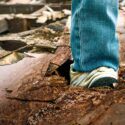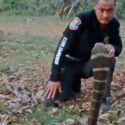Lice are something we might associate with little kids. But the little buggers do not discriminate. They’ll set up shop anywhere they can find a warm home.
Can they jump from one head to another? How can you kill them? How can they kill you?
Contrary to popular belief, lice cannot jump from one head to another. But these wingless creatures can crawl from victim to victim. They can even hitch a ride on things like brushes, combs, rubber bands and hats. So if you don’t want to fall victim to this tiny little pest, follow these steps.
Step 1: Prepare for Battle
Head to the pharmacy and grab the best lice medication they have. Buy a small-toothed comb, something that you won’t mind tossing out after the battle. It’s even better if the lice treatment kit has a comb with fine metal teeth set close together. Lice eggs, or nits, are laid 0.635 centimeters (one-quarter of an inch) from a person’s scalp, and these insects use a thick but transparent, sticky, glue-like substance to attach themselves. So the lice will not come off without a fight.
Now it’s time to assess the situation as the clock is ticking. A female louse can lay up to 10 eggs per day, and each egg hatches into a nymph within 7-10 days. These are adolescent lice. So inspect the scalp, and look for little white bumps close to the hairs’ roots. At this point, you might want to scream or throw up, but don’t.
There’s work to be done. Grab the medication you just purchased, put on some gloves, and maybe don an N-95 mask handy. Because the smells you’re about to experience are pretty intense.
Step 2: Lock and Load
Now that you’re all prepped, it’s time to go in. Carefully, slowly and deliberately comb through the hair. Apply the medication and run the very fine-tooth comb through every bit of hair on the scalp. Dunk the comb in very hot water before reapplying the medicine. Remember, these little bloodsuckers won’t live long if you separate them from their food source.
But they can hold their breath for up to 8 hours. And unfortunately, they are incredibly skilled at hanging on. Their bodies have short legs with really grippy claws at the end that can clench a shaft of hair in a shower, a pool and even powerful winds. The CDC warns people not to use combination shampoo and conditioner, or conditioner, before using lice medicine. And don’t wash the hair for 1-2 days after removing the lice medicine.
And lice are more than annoying and gross little insects. Do you know they can kill? In early May 2021, an Indiana, U.S. mother was arrested and charged with neglect when her four-year-old daughter nearly died from a lice infestation.
The Department of Child Services notified police that the little girl was in the hospital due to a severe lice infestation. Her blood levels were a fraction of what they should have been because lice were feeding off her blood for so long.
Sadly, in Georgia, another little girl wasn’t so lucky. She suffered a lice infestation that might have lasted up to six years. Eventually, she became severely anemic and died from cardiac arrest. And her parents could face second-degree murder charges for her death.
I know these stories are extreme, but it’s important to know the potential dangers. And your battle isn’t over yet, so take a deep breath.
Step 3: Keep Calm and Wash On
Once you have checked, treated and cleaned all the hair, load up the laundry. Wash all the bedding used by the people who have lice and their bedmates using the hot water cycle at 54 °C (130°F) and the high heat drying cycle.. If a couple of lice are still clinging to life, the heat should kill them. The CDC recommends vacuuming the floor and furniture, especially where the person with lice sat or laid, but you don’t need to use fumigating sprays.
Step 4: The Call of Shame
This may not be easy to do, but it’s the responsible thing. Let anyone who might have had close contact with the contaminated person know about the lice. It’s OK. It’s not a big deal. An estimated 6-12 million infestations occur in the United States alone each year.
Step 5: Back-check
After using the medicine, re-examine the scalp in 8-12 hours. If you see small, white bugs, but they’re not moving, sit tight. If they’re still moving around, call your doctor and ask for help. You might need a prescription because some lice are resistant to the medicine in over-the-counter treatments. Keep checking the hair every two to three days for the next two or three weeks.
Being caught unprepared and unaware once will be enough to encourage better cleaning habits. Just remember to soak all those combs and brushes in hot water, at least 54 °C (130 °F) for 5–10 minutes.
Sources
- “Interesting Head Lice Facts And Statistics”. 2018. Lice Troopers, Inc. | licetroopers.com.
- “Lice Lies – Fact Vs. Fiction”. 2011. Kennesaw, GA Patch.
- “The Dangers Of Not Treating A Lice Outbreak”. 2021. Healthline.
- “Lice infestation linked to 12-year-old Georgia girl’s death; parents charged”. 2021. WSB-TV Channel 2 – Atlanta.
- “CDC – Lice – Head Lice – General Information – Frequently Asked Questions (Faqs)”. 2021. cdc.gov.
- “The 4 Head Lice Facts That Every Parent Needs To Know”. 2021. Cleveland Clinic.
- “‘Way More Severe Cases’: Resilient Head Lice A Concern For Back-To-School In Ontario”. Appia, Veronica. 2020. toronto.com.



























